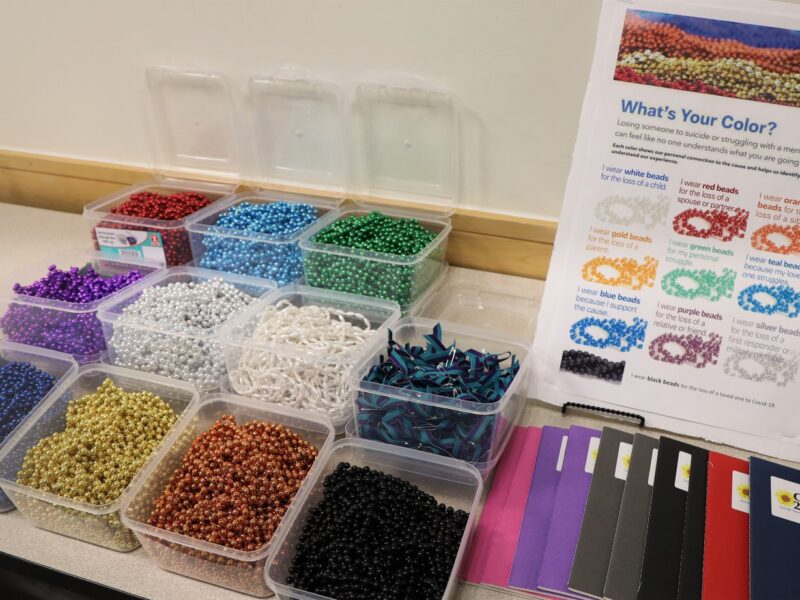Wyoming’s Suicide Rate for 2020 Ranks as Second Highest in More Than a Decade
State has suicide rate more than double the nationwide rate, numbers show
- Published In: Other News & Features
- Last Updated: Nov 23, 2021

These various colored bead necklaces symbolize the loss of a loved one or the personal struggle facing attendees at the Grace for 2 Brothers Foundation's International Survivors of Suicide Loss Day event. The conference was held Nov. 20 at the Laramie County Library in Cheyenne. (Photo by Mandy Ludtke, special to the Wyoming Truth)
By Shen Wu Tan
Special to the Wyoming Truth
Wyoming recorded its second-highest suicide rate in more than a decade, a recent state health report shows. The state also led the nation in the rate of suicides as of 2019, though it’s not clear whether Wyoming maintained that unenviable position last year as figures haven’t been released yet. Even more unclear: What is causing so many suicides?
The state had a suicide rate of 30.6 deaths per 100,000 people in 2020, slightly higher than the 29.6 rate recorded the previous year. The 2020 suicide rate trails the state’s 15-year high of 31.2 in 2012, according to data released by the Wyoming Department of Health last month. Data shows 182 Wyoming residents took their lives last year, mostly by firearms.
Since 2006, when Wyoming recorded a suicide rate of 21.4 deaths per 100,000 people, the state’s suicide rate has climbed nearly 43%.
The suicide rate is also more than double the provisional 2020 national suicide rate of 13.5 deaths per 100,000 people, calculated by the Centers for Disease Control and Prevention earlier this month. From 2011 to 2020, Wyoming had a suicide rate of 25.9 deaths per 100,000 people.

“With Wyoming’s low population, there can be swings in numbers and rates that may appear especially dramatic. That said, Wyoming certainly has had historically high suicide rates,” said Kim Deti, spokesperson for the Wyoming Department of Health. We are unable to provide a definitive answer about Wyoming’s unfortunately high suicide rates. While there are many potential theories, it is likely a combination of factors. Some of these factors include high firearm ownership rate per capita, access to lethal means, social isolation, socioeconomic status, the cultural stigma around mental health, and asking for help and access to mental health services.”
More than 70%, or 128 residents, used a firearm to take their own lives last year, the health department found. Twenty-nine residents (nearly 16%) hanged themselves. Nineteen residents (about 10%) poisoned themselves, and six residents (about 3%) used other means.
For 2019, Wyoming ranked as the leading state with the highest suicide rate of 29.4, according to a report from the American Association of Suicidology in Washington, D.C. It is unclear how Wyoming ranks for last year since data for U.S. states has not yet been finalized and released by the Centers for Disease Control and Prevention.
Katie Levine, area director of the American Foundation for Suicide Prevention for the Montana and Wyoming chapters, said there’s a general saying that for every person who dies by suicide at least 10 people are affected.
“I’m going to guess that number is a lot greater, especially in small towns,” she said. “In Wyoming, in Montana, any small town where suicide happens, everybody knows everybody, so it does impact an entire community and shakes an entire community.”

Wyoming and other Rocky Mountain states consistently rank within the top five for the highest suicide rates in the United States, said Levine, noting one major reason is the lack of access to care in rural or frontier areas.
The COVID-19 pandemic could have played a role in the state’s higher suicide rate last year as well, experts say.
“Many people had their entire lives turned upside down in 2020, whether job loss, furloughs, working from home, schooling from home, etc.,” said Jeremy Bay, executive director of the Grace For 2 Brothers Foundation, a suicide prevention organization in Cheyenne.
Another contributing factor to the high suicide rate is the stigma surrounding mental health issues that exists within Wyoming, said Joann Stadel, board secretary for the American Foundation for Suicide Prevention for Wyoming and volunteer crisis counselor for the Crisis Text Line. “Spread out, there’s very much a cowboy mentality of pick yourself up by your bootstraps and don’t talk about your mental health or if you’re suicidal,” she said. “I believe that directly comes from the stigma of having mental health issues or speaking up at all to say, ‘Hey, I’m not OK inside right now. I need someone to listen to me.’”
Stadel, who resides in Cheyenne, added, “A lot of people don’t speak up before the point of being suicidal. And it breaks my heart because this is my home state, this is my community.”
Stadel said she began volunteering for the suicide foundation in 2019, two years after her third suicide attempt in 2017 at the age of 32. She said she also has lost three friends and a family member to suicide.
Suicide rates from county to county in Wyoming last year varied widely, state health department data shows. Hot Springs in 2020 had the highest suicide rate of the counties that had data available. The county reported a suicide rate of 83.7 per 100,000 in 2020 while Natrona had the lowest rate at 20.2. Laramie County ranked on the lower end with a 28.2 suicide rate.
The 2020 suicide rate for Teton County was not available; however, the county recorded the lowest suicide rate, 12.5 per 100,000, among Wyoming’s 23 counties from 2011 to 2020.
“It can vary, and rates can switch between counties yearly. There are a lot of variables,” said Beverly Shore, a county prevention specialist for Teton County. “Teton has an abundance of financial resources to provide 24/7 mental health crisis help and substance abuse help. We have a lot of resources and not-for-profits that help individuals and families pay for rent, food, utilities, which can help ease mental stressors. Teton has a lot of mental health therapy agencies that collaborate with town and county agencies for community programming and training for free.”
Only four counties, including Teton County, had a suicide rate lower than 20 per 100,000 from 2011 to 2020. The other counties that reported lower suicide rates were Albany, Goshen and Washakie, says a state health department report.
Hot Springs was the only county to record a suicide rate above 40—at 45.9—during the 10-year span. However, five other counties had suicide rates higher than 30: Fremont, Johnson, Niobrara, Platte and Uinta, according to state health data. The report cautions that the rates are based on a small population or a small number of events, noting that while Niobrara’s suicide rates have seen large fluctuations from year to year, the number of suicides in the county are small.
Levine said Wyoming has recently expanded some of its suicide prevention resources, including adding lifeline call centers in Casper and Greybull, which it did not have. However, she said funding is needed to staff the call centers 24 hours a day.
Additionally, legislation that would have required school districts to teach students about suicide prevention failed to pass during this year’s general session, said Bay, head of the Cheyenne foundation. Some legislators expressed concerns that the proposal would add to the burden on teachers while others said they were worried about costs, the Casper Star-Tribune reported.
“However, I believe the tide is turning on this topic, and many leaders in education believe that we are not doing enough to keep our kids safe – hopefully this topic will come up again soon in legislation,” Bay said.
School districts are required to teach staff and teachers about suicide prevention under the Jason Flatt Act, which the state adopted in 2014. It mandates teachers receive at least eight hours of training over a four-year period. However, the law does not apply to students.
“We also have room to improve in the arena of primary prevention at the community level – we’re working with this with partners at the state level, but we’d also welcome input from communities on how we can work together to zero suicides,” Bay said. “Things that can help improve community protective factors include access to affordable housing; access to health, food, safety; and access to mental and physical health care.”
While talking about suicide might be uncomfortable for some, crisis counselor Stadel said it’s a conversation people can’t be afraid to have.
She said several free programs in Wyoming can equip people on how to help prevent suicides. For instance, she said the American Foundation for Suicide Prevention offers a free one-hour webinar called “Talk Saves Lives” that teaches people how to recognize signs that someone might be suicidal, how to ask them that question and how to direct them to professional help.
“I want someone thinking of completing suicide to know that even if you don’t have the support system in your life that you deserve, there are strangers who care immensely,” she said, noting that people are available around the clock by either Crisis Text Line or many call centers.
“I know what it’s like to be in that dark place where you don’t see hope,” Stadel said. “I never want anyone to feel the way I have felt on either end, either trying to take my life or losing someone who’s completed suicide.
“There are people who will sit in your darkness with you until there is some light again,” she said. “You just need to reach out.”
For every person who dies by suicide annually, there are 316 people who seriously consider suicide but do not kill themselves, according to the National Suicide Prevention Lifeline. The American Association of Suicidology says over 90% of people who attempt suicide go on to live out their lives.













